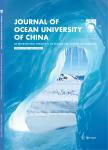Trophic Interaction in a Portunus rituberculatus Polyculture Ecosystem Based on Carbon and Nitrogen Stable Isotope Analysis
Trophic Interaction in a Portunus rituberculatus Polyculture Ecosystem Based on Carbon and Nitrogen Stable Isotope Analysis作者机构:The Key Laboratory of Mariculture of Ministry of EducationFisheries CollegeOcean University of ChinaQingdao 266003China Marine Fishery Technology Guiding Office of GanyuLianyungang 222100China Marine and Fisheries Research Institute of RizhaoRizhao 276800China
出 版 物:《Journal of Ocean University of China》 (中国海洋大学学报(英文版))
年 卷 期:2018年第17卷第6期
页 面:1432-1440页
核心收录:
学科分类:07[理学]
基 金:supported by the National Great Project of Scientific and Technical Supporting Programs(No.2011BAD13B03) the Programs for Excellent Youth Foundation of Shandong Province(No.JQ201009)
主 题:trophic interaction Portunus trituberculatus polyculture stable isotope diet composition
摘 要:Trophic interaction among various biomass groups in a swimming crab Portunus trituberculatus polyculture pond was investigated using carbon and nitrogen stable isotope analysis. The polycultured animal species also included white shrimp Litopenaeus vannamei, short-necked clam Ruditapes philippinarum, and redlip mullet Liza haematochila. The mean δ^(13)C value for all the biomass groups in polyculture ecosystem ranged from -25.61‰ to -16.60‰, and the mean δ^(15)N value ranged from 6.80‰ to 13.09‰. Significant difference in the δ^(13)C value was found between particulate organic matter(POM) and sediment organic matter(SOM)(P 0.05), indicating that these two organic matter pools have different material sources. Assuming that a ^(13)C-enrichment factor of 1.00‰ and a ^(15)N-enrichment factor of 2.70‰ existed between consumer and prey, diets of the four cultured animals were estimated using a stable isotope mixing model. The estimated model results indicated that P. trituberculatus mainly feed on Aloidis laevis; L. vannamei mainly feed on shrimp feed; while A. laevis, R. philippinarum and L. haematochelia mainly feed on POM. Shrimp feed was also an important food source of R. philippinarum and L. haematochelia. The diets of P. trituberculatus, L. vannamei, R. philippinarum, and L. haematochila showed complementary effects in this polyculture ecosystem. Our finding indicated that the polyculture of these four organisms with suitable farming density could make an effective use of most of the food sources, which can make a highly efficient polyculture ecosystem.




